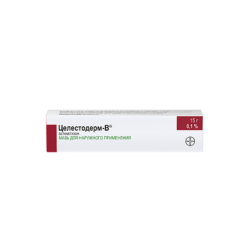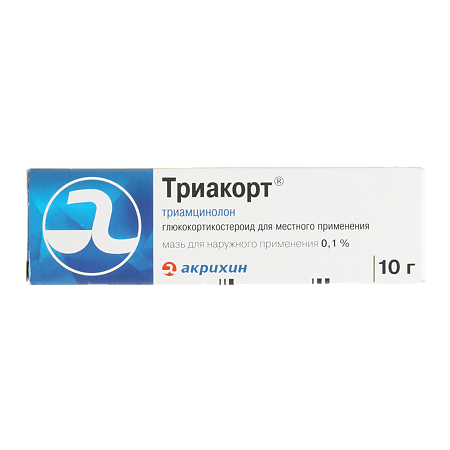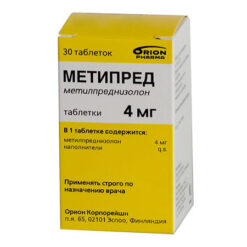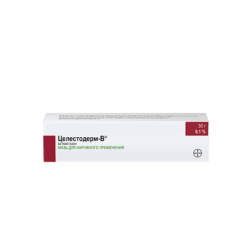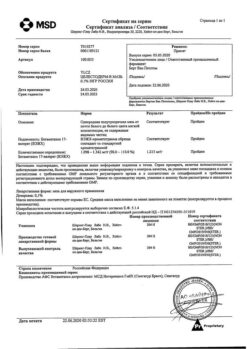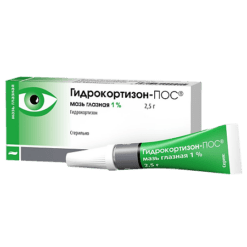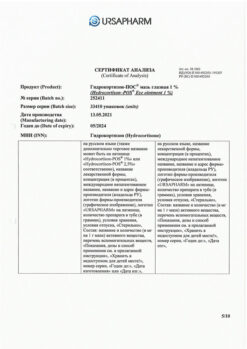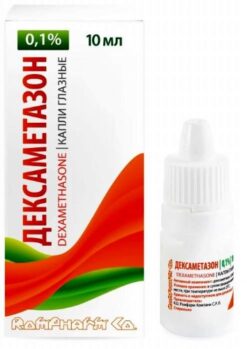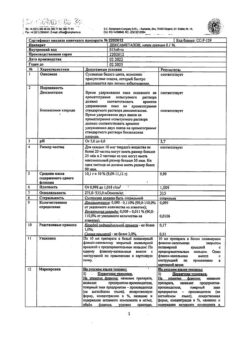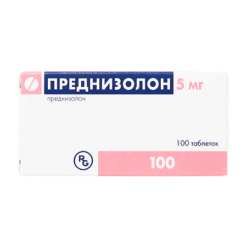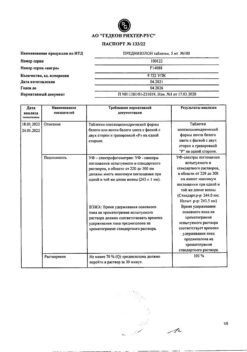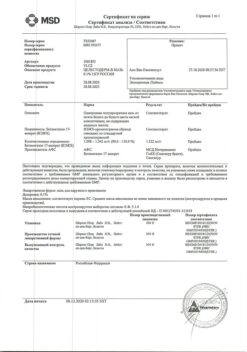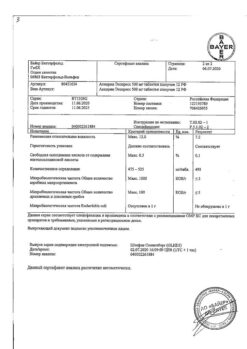Subtotal: €5.32
Triacort, ointment 0.1% 10 g
€6.15 €5.13
GCS. Suppresses functions of leukocytes and tissue macrophages. Restricts the migration of leukocytes to the area of inflammation. Disrupts the ability of macrophages to phagocytosis, as well as the formation of interleukin-1. Promotes stabilization of lysosomal membranes, thus reducing the concentration of proteolytic enzymes in the area of inflammation. Reduces capillary permeability, caused by the release of histamine. It suppresses fibroblast activity and collagen formation.
Inhibits the activity of phospholipase A2, which leads to suppression of the synthesis of prostaglandins and leukotrienes. Suppresses the release of COX (mainly COX-2), which also helps to reduce the production of prostaglandins.
Decreases the number of circulating lymphocytes (T- and B-cells), monocytes, eosinophils and basophils due to their movement from the vascular bed to lymphoid tissue; inhibits formation of antibodies.
It suppresses release of ACTH and β-lipotropin by pituitary, but does not decrease circulating β-endorphin. It suppresses the secretion of TSH and FSH.
It has a vasoconstrictor effect when directly applied to the blood vessels.
It has a pronounced dose-dependent effect on the metabolism of carbohydrates, proteins and fats. It stimulates gluconeogenesis, promotes amino acid uptake by liver and kidneys and increases activity of gluconeogenesis enzymes. In the liver, it increases glycogen deposition by stimulating glycogen synthetase activity and glucose synthesis from protein metabolism products. Increased blood glucose activates insulin release.
Suppresses glucose uptake by fat cells, which leads to the activation of lipolysis. However, due to an increase in insulin secretion, lipogenesis is stimulated, which contributes to fat accumulation.
It has a catabolic effect in the lymphoid and connective tissue, muscles, adipose tissue, skin, bone tissue.
Osteoporosis and Itzenko-Cushing’s syndrome are the main factors limiting long-term GCS therapy. Growth suppression in children may occur as a result of catabolic action.
In high doses, it may increase brain tissue excitability and contribute to lowering the seizure threshold. It stimulates excessive production of hydrochloric acid and pepsin in the stomach, which promotes development of peptic ulcer.
When used systemically, the therapeutic activity is due to anti-inflammatory, anti-allergic, immunosuppressive and antiproliferative actions.
Triamcinolone acetonide has therapeutic activity when used topically and topically due to its anti-inflammatory, anti-allergic and anti-exudative (due to its vasoconstrictor effect) action.
In terms of anti-inflammatory activity, triamcinolone acetonide is 6 times more active than hydrocortisone. Mineralocorticoid activity of triamcinolone acetonide is practically absent.
Indications
For systemic use: bronchial asthma, chronic bronchitis with broncho-obstructive syndrome, pemphigoid, psoriasis, dermatitis.
Intra-articular administration: chronic inflammatory diseases of the joints, exudative arthritis, gout, edema of the joints, blockade of the shoulder joint, chronic inflammation of the inner layer of the joint capsule.
For external use: eczema, psoriasis, neurodermatitis, various types of dermatitis and other inflammatory and allergic skin diseases of non-microbial etiology (as part of complex therapy).
Pharmacological effect
GCS. Suppresses the functions of leukocytes and tissue macrophages. Limits the migration of leukocytes to the area of inflammation. It disrupts the ability of macrophages to phagocytose, as well as to form interleukin-1. Helps stabilize lysosomal membranes, thereby reducing the concentration of proteolytic enzymes in the area of inflammation. Reduces capillary permeability due to the release of histamine. Suppresses fibroblast activity and collagen formation.
Inhibits the activity of phospholipase A2, which leads to suppression of the synthesis of prostaglandins and leukotrienes. Suppresses the release of COX (mainly COX-2), which also helps to reduce the production of prostaglandins.
Reduces the number of circulating lymphocytes (T- and B-cells), monocytes, eosinophils and basophils due to their movement from the vascular bed into the lymphoid tissue; suppresses the formation of antibodies.
Suppresses the release of ACTH and β-lipotropin by the pituitary gland, but does not reduce the level of circulating β-endorphin. Inhibits the secretion of TSH and FSH.
When directly applied to blood vessels, it has a vasoconstrictor effect.
It has a pronounced dose-dependent effect on the metabolism of carbohydrates, proteins and fats. Stimulates gluconeogenesis, promotes the uptake of amino acids by the liver and kidneys and increases the activity of gluconeogenesis enzymes. In the liver, it enhances the deposition of glycogen, stimulating the activity of glycogen synthetase and the synthesis of glucose from the products of protein metabolism. An increase in blood glucose levels activates the release of insulin.
Suppresses the uptake of glucose by fat cells, which leads to activation of lipolysis. However, due to increased insulin secretion, lipogenesis is stimulated, which promotes fat accumulation.
It has a catabolic effect in lymphoid and connective tissue, muscles, adipose tissue, skin, bone tissue.
Osteoporosis and Itsenko-Cushing syndrome are the main factors limiting long-term GCS therapy. As a result of the catabolic effect, growth suppression in children is possible.
In high doses, it can increase the excitability of brain tissue and help lower the threshold for convulsive readiness. Stimulates excess production of hydrochloric acid and pepsin in the stomach, which contributes to the development of peptic ulcers.
When used systemically, the therapeutic activity is due to anti-inflammatory, antiallergic, immunosuppressive and antiproliferative effects.
When applied externally and locally, the therapeutic activity of triamcinolone acetonide is due to its anti-inflammatory, antiallergic and antiexudative (due to the vasoconstrictor effect) effect.
In terms of anti-inflammatory activity, triamcinolone acetonide is 6 times more active than hydrocortisone. Triamcinolone acetonide has virtually no mineralocorticoid activity.
Special instructions
Not intended for intravenous administration.
Use with caution and under strict medical supervision for edema syndrome, obesity, mental illness and gastrointestinal diseases. During treatment, it is recommended to take vitamin D and eat foods rich in calcium.
For external use, to prevent local infectious complications, it is recommended to use it in combination with antimicrobial agents.
Parenteral use in children under 6 years of age is not recommended; at the age of 6-12 years – according to strict indications.
Long-term external use in children, regardless of age, should be avoided.
Active ingredient
Triamcinolone
Composition
Active ingredient:
triamcinolone acetonide 0.1 g;
Excipients:
glycerin,
propylene glycol,
dimexide,
Vaseline,
stearic acid,
emulsifying wax,
purified water.
Contraindications
History of acute psychosis, active form of tuberculosis, myasthenia gravis, neoplasms with metastases, diverticulitis, gastric and duodenal ulcers, arterial hypertension, Itsenko-Cushing syndrome, renal failure, history of thrombosis and embolism, osteoporosis, diabetes mellitus, hidden foci of infection, amyloidosis, syphilis, fungal diseases, viral infections (in including those caused by Herpes simplex and Varicella zoster), amoebic infections, poliomyelitis (except for the bulbar-encephalitis form), gonococcal or tuberculous arthritis, vaccination period, lymphadenitis after BCG vaccination, glaucoma, infected skin lesions.
Side Effects
From the endocrine system: redistribution of adipose tissue, menstrual irregularities, increased blood glucose levels, suppression of adrenal function, “moon face”, stretch marks, hirsutism, acne.
Metabolic: edema, electrolyte imbalance, negative nitrogen balance, growth retardation in children.
From the digestive system: steroid gastric ulcer, erosive and ulcerative lesions of the gastrointestinal tract, acute pancreatitis.
From the central nervous system: convulsions, sleep disturbances, mental disorders, headaches and dizziness, weakness.
From the musculoskeletal system: myopathy, osteoporosis.
From the cardiovascular system: arterial hypertension.
From the blood coagulation system: thromboembolism.
From the organ of vision: visual disturbances, posterior subcapsular cataracts, increased intraocular pressure or exophthalmos, anaphylactic reactions.
Reactions caused by immunosuppressive effects: exacerbation of infectious diseases.
With intra-articular administration: possible joint pain, irritation at the site of needle insertion, depigmentation, sterile abscess, skin atrophy; when administered in doses of more than 40 mg, resorptive side effects are possible.
When used externally: possible itching, skin irritation, late reactions such as eczema, steroid acne, purpura. With prolonged use of the ointment, the development of secondary infectious lesions and atrophic changes in the skin is possible.
Interaction
When used simultaneously with anabolic steroids and androgens, the risk of developing peripheral edema and acne increases.
When used simultaneously with antithyroid drugs and thyroid hormones, changes in thyroid function may occur.
When used simultaneously with histamine H1 receptor blockers, the effect of triamcinolone is reduced; with hormonal contraceptives – the effect of triamcinolone is potentiated.
Hypocalcemia associated with the use of triamcinolone may lead to an increase in the duration of neuromuscular blockade caused by the action of depolarizing muscle relaxants when used concomitantly.
When used simultaneously with immunosuppressants, the risk of developing bacterial and viral infections increases.
When used simultaneously with potassium-sparing diuretics, hypokalemia is possible.
With simultaneous use, it is possible to reduce the effectiveness of indirect anticoagulants, heparin, streptokinase, urokinase, and increase the risk of erosive and ulcerative lesions and bleeding from the gastrointestinal tract.
When used simultaneously with NSAIDs (including acetylsalicylic acid), the risk of erosive and ulcerative lesions and bleeding from the gastrointestinal tract increases.
With simultaneous use, the effect of oral hypoglycemic agents and insulin is weakened; with laxatives – hypokalemia is possible; with cardiac glycosides – the risk of developing heart rhythm disturbances and other toxic effects of glycosides increases.
When used simultaneously with tricyclic antidepressants, an increase in mental disorders associated with triamcinolone may be possible.
Storage conditions
At a temperature of 12–15 °C
Shelf life
2 years
Manufacturer
Akrikhin JSC, Russia
| Shelf life | 2 years |
|---|---|
| Conditions of storage | At 12-15 °C |
| Manufacturer | Akrihin HFC JSC, Russia |
| Medication form | topical ointment |
| Brand | Akrihin HFC JSC |
Related products
Buy Triacort, ointment 0.1% 10 g with delivery to USA, UK, Europe and over 120 other countries.

